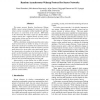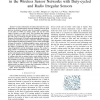28 search results - page 3 / 6 » Awaking and sleeping of a complex network |
IPCCC
2007
IEEE
15 years 6 months ago
2007
IEEE
The wireless sensor network (WSN) is one of the most promising technologies which helps making our society safe, secure, and comfortable. A WSN as a social infrastructure must tra...
SENSYS
2010
ACM
14 years 9 months ago
2010
ACM
We present A-MAC, a receiver-initiated link layer for low-power wireless networks that supports several services under a unified architecture, and does so more efficiently and sca...
125
click to vote
WINET
2011
14 years 6 months ago
2011
Sleep scheduling, which is putting some sensor nodes into sleep mode without harming network functionality, is a common method to reduce energy consumption in dense wireless sensor...
BROADNETS
2004
IEEE
15 years 3 months ago
2004
IEEE
This paper presents Random Asynchronous Wakeup (RAW), a power saving technique for sensor networks that reduces energy consumption without significantly affecting the latency or c...
128
click to vote
ICC
2011
IEEE
13 years 11 months ago
2011
IEEE
—Location information of nodes is the basis for many applications in wireless sensor networks (WSNs). However, most previous localization methods make the unrealistic assumption:...


